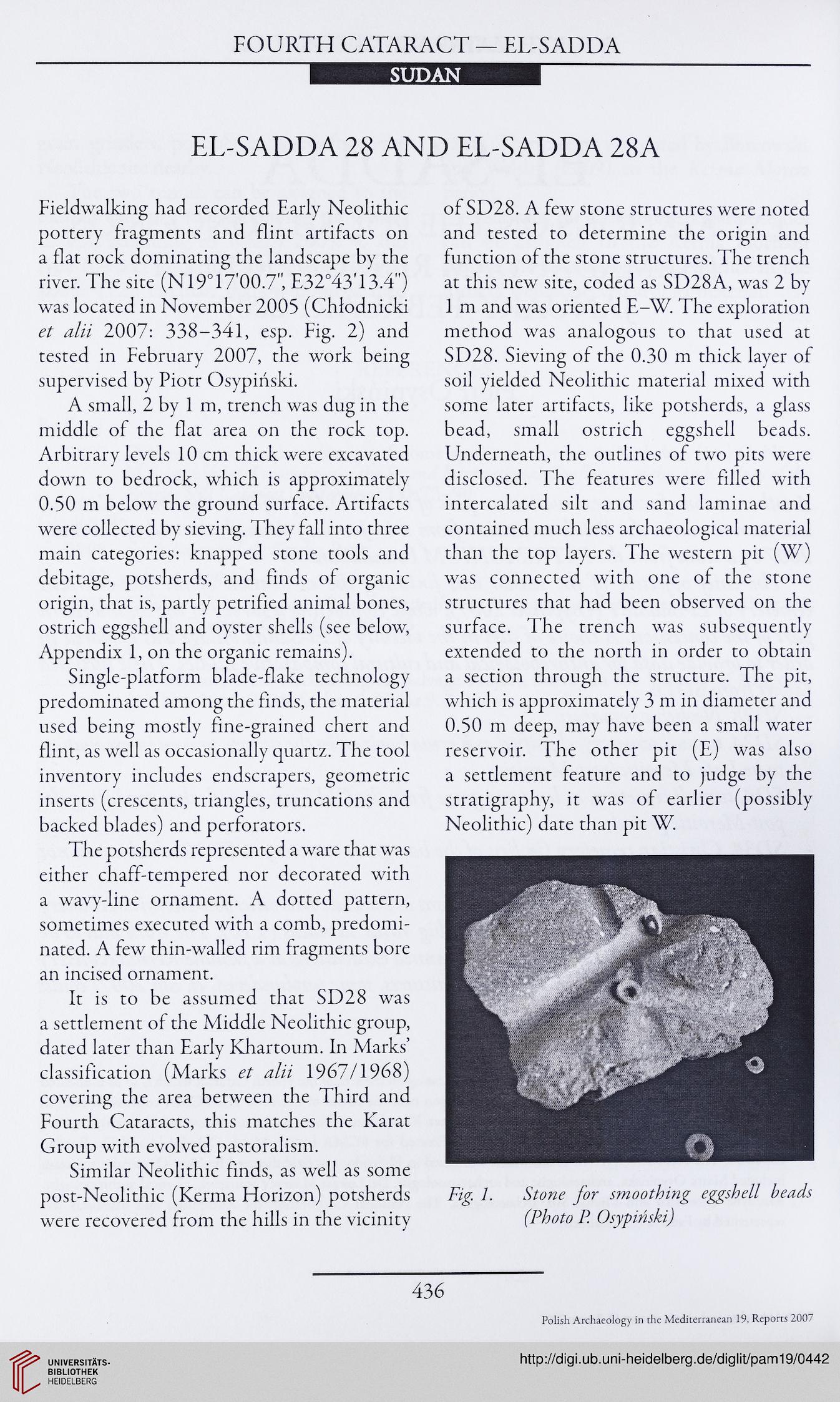FOURTH CATARACT — EL-SAD DA
SUDAN
EL-SADDA 28 AND EL-SADDA 28A
Fieldwalking had recorded Early Neolithic
pottery fragments and flint artifacts on
a flat rock dominating the landscape by the
river. The site (Ν19Τ7Ό0.7", E32°43'13.4")
was located in November 2005 (Chlodnicki
et alii 2007: 338-341, esp. Fig. 2) and
tested in February 2007, the work being
supervised by Piotr Osypihski.
A small, 2 by 1 m, trench was dug in the
middle of the flat area on the rock top.
Arbitrary levels 10 cm thick were excavated
down to bedrock, which is approximately
0.50 m below the ground surface. Artifacts
were collected by sieving. They fall into three
main categories: knapped stone tools and
debitage, potsherds, and finds of organic
origin, that is, partly petrified animal bones,
ostrich eggshell and oyster shells (see below,
Appendix 1, on the organic remains).
Single-platform blade-flake technology
predominated among the finds, the material
used being mostly fine-grained chert and
flint, as well as occasionally quartz. The tool
inventory includes endscrapers, geometric
inserts (crescents, triangles, truncations and
backed blades) and perforators.
The potsherds represented a ware that was
either chaff-tempered nor decorated with
a wavy-line ornament. A dotted pattern,
sometimes executed with a comb, predomi-
nated. A few thin-walled rim fragments bore
an incised ornament.
It is to be assumed that SD28 was
a settlement of the Middle Neolithic group,
dated later than Early Khartoum. In Marks’
classification (Marks et alii 1967/1968)
covering the area between the Third and
Fourth Cataracts, this matches the Karat
Group with evolved pastoralism.
Similar Neolithic finds, as well as some
post-Neolithic (Kerma Horizon) potsherds
were recovered from the hills in the vicinity
of SD28. A few stone structures were noted
and tested to determine the origin and
function of the stone structures. The trench
at this new site, coded as SD28A, was 2 by
1 m and was oriented E-W. The exploration
method was analogous to that used at
SD28. Sieving of the 0.30 m thick layer of
soil yielded Neolithic material mixed with
some later artifacts, like potsherds, a glass
bead, small ostrich eggshell beads.
Underneath, the outlines of two pits were
disclosed. The features were filled with
intercalated silt and sand laminae and
contained much less archaeological material
than the top layers. The western pit (W)
was connected with one of the stone
structures that had been observed on the
surface. The trench was subsequently
extended to the north in order to obtain
a section through the structure. The pit,
which is approximately 3 m in diameter and
0.50 m deep, may have been a small water
reservoir. The other pit (E) was also
a settlement feature and to judge by the
stratigraphy, it was of earlier (possibly
Neolithic) date than pit W.
Fig. 1. Stone for smoothing eggshell heads
(Photo P. Osypihski)
43 6
Polish Archaeology in the Mediterranean 19, Reports 2007
SUDAN
EL-SADDA 28 AND EL-SADDA 28A
Fieldwalking had recorded Early Neolithic
pottery fragments and flint artifacts on
a flat rock dominating the landscape by the
river. The site (Ν19Τ7Ό0.7", E32°43'13.4")
was located in November 2005 (Chlodnicki
et alii 2007: 338-341, esp. Fig. 2) and
tested in February 2007, the work being
supervised by Piotr Osypihski.
A small, 2 by 1 m, trench was dug in the
middle of the flat area on the rock top.
Arbitrary levels 10 cm thick were excavated
down to bedrock, which is approximately
0.50 m below the ground surface. Artifacts
were collected by sieving. They fall into three
main categories: knapped stone tools and
debitage, potsherds, and finds of organic
origin, that is, partly petrified animal bones,
ostrich eggshell and oyster shells (see below,
Appendix 1, on the organic remains).
Single-platform blade-flake technology
predominated among the finds, the material
used being mostly fine-grained chert and
flint, as well as occasionally quartz. The tool
inventory includes endscrapers, geometric
inserts (crescents, triangles, truncations and
backed blades) and perforators.
The potsherds represented a ware that was
either chaff-tempered nor decorated with
a wavy-line ornament. A dotted pattern,
sometimes executed with a comb, predomi-
nated. A few thin-walled rim fragments bore
an incised ornament.
It is to be assumed that SD28 was
a settlement of the Middle Neolithic group,
dated later than Early Khartoum. In Marks’
classification (Marks et alii 1967/1968)
covering the area between the Third and
Fourth Cataracts, this matches the Karat
Group with evolved pastoralism.
Similar Neolithic finds, as well as some
post-Neolithic (Kerma Horizon) potsherds
were recovered from the hills in the vicinity
of SD28. A few stone structures were noted
and tested to determine the origin and
function of the stone structures. The trench
at this new site, coded as SD28A, was 2 by
1 m and was oriented E-W. The exploration
method was analogous to that used at
SD28. Sieving of the 0.30 m thick layer of
soil yielded Neolithic material mixed with
some later artifacts, like potsherds, a glass
bead, small ostrich eggshell beads.
Underneath, the outlines of two pits were
disclosed. The features were filled with
intercalated silt and sand laminae and
contained much less archaeological material
than the top layers. The western pit (W)
was connected with one of the stone
structures that had been observed on the
surface. The trench was subsequently
extended to the north in order to obtain
a section through the structure. The pit,
which is approximately 3 m in diameter and
0.50 m deep, may have been a small water
reservoir. The other pit (E) was also
a settlement feature and to judge by the
stratigraphy, it was of earlier (possibly
Neolithic) date than pit W.
Fig. 1. Stone for smoothing eggshell heads
(Photo P. Osypihski)
43 6
Polish Archaeology in the Mediterranean 19, Reports 2007




